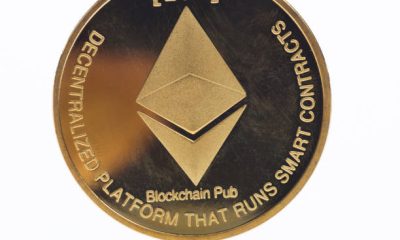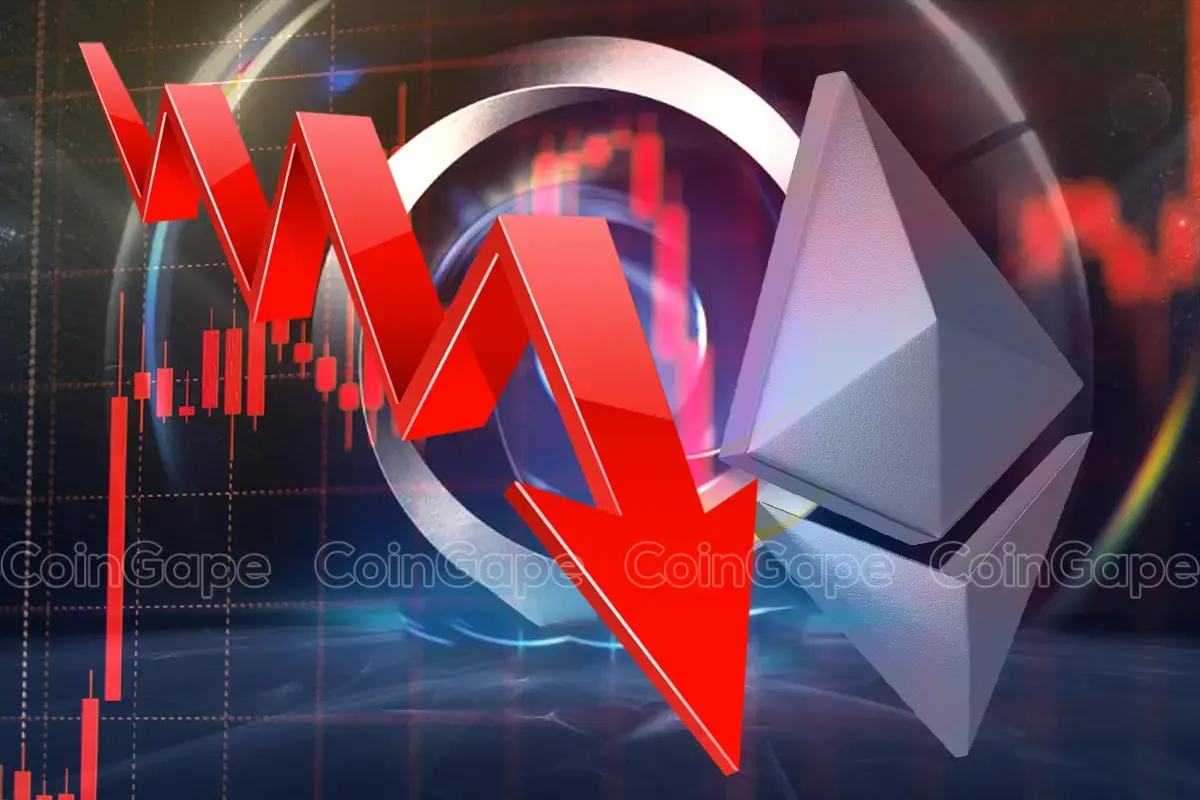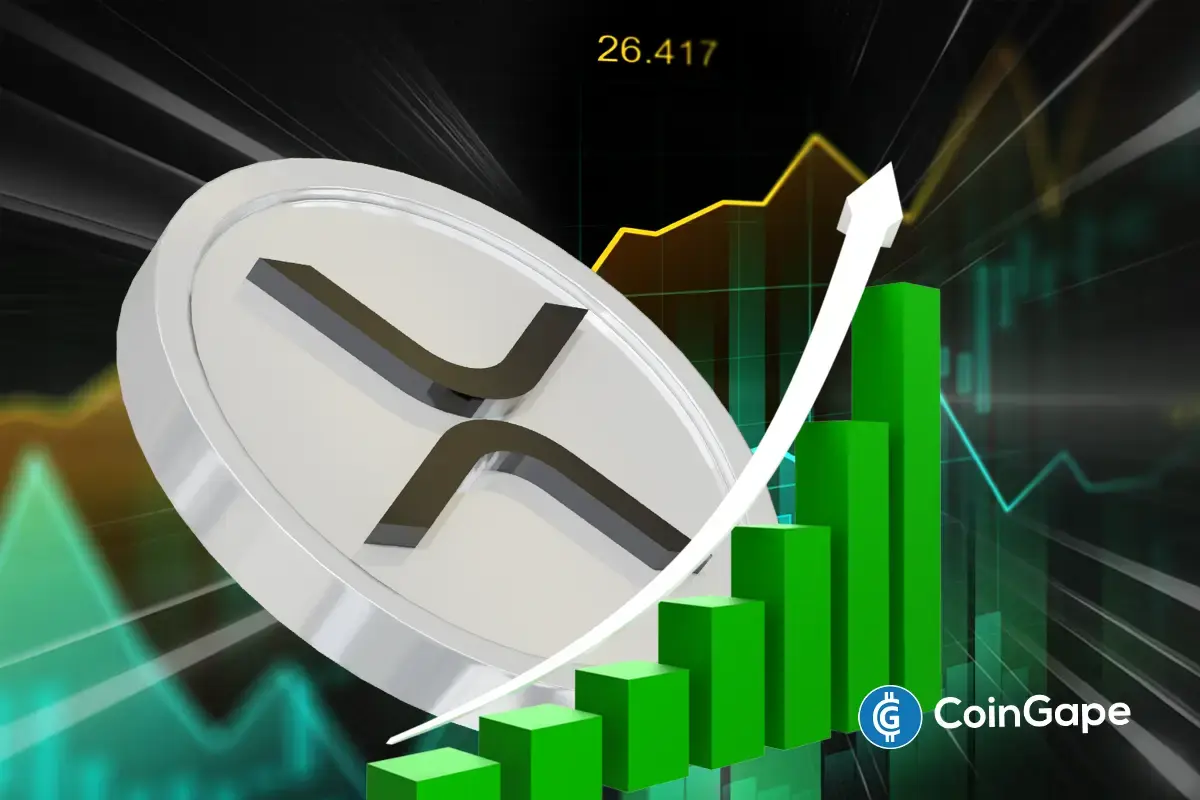Market
Justin Sun, Vitalik Buterin Speak Amid Ethereum Reform Debate

TRON founder Justin Sun has offered a hypothetical plan for Ethereum and the Ethereum Foundation (EF) under his leadership. His remarks come amid controversy over EF’s leadership transformation.
In a series of posts on X (formerly Twitter), Ethereum co-founder Vitalik Buterin outlined the reforms’ goals and progress. He highlighted improvements in technical expertise, ecosystem engagement, and operational efficiency.
Justin Sun Outlines Blueprint for Ethereum Leadership
The TRON executive shared ambitious remarks on how he would lead the Ethereum Foundation if given the opportunity. Sun’s vision, shared on X, outlined a four-point plan to radically restructure EF operations, optimize Ethereum’s economic model, and drive the price of ETH to $10,000.
“If EF and Ethereum were under my leadership, ETH would hit $10,000,” Sun claimed.
Sun proposed an immediate halt to ETH sales for three years to stabilize supply and boost market confidence. He suggested covering EF’s operational costs through DeFi protocols like Aave, staking yields, and stablecoin borrowing, aligning with Ethereum’s deflationary goals.
A key component of his plan involves imposing significant taxes on Layer 2 (L2) solutions, aiming to generate $5 billion annually. The collected taxes would go toward exclusively repurchasing and burning ETH, further enhancing its scarcity and value.
Sun also called for a drastic downsizing of EF staff, retaining only top performers and offering them significant salary increases. This merit-based approach, he argued, would streamline operations and improve efficiency.
Finally, Sun emphasized adjusting node rewards and increasing fee burns to reinforce Ethereum’s deflationary narrative. He proposed redirecting all resources toward Ethereum’s core L1 development, focusing on scalability, security, and adoption. Justin Sun’s plan sparked a mixed response, with some applauding the bold vision.
“These are all very practical suggestions. Please pay attention to them and refer to them, Vitalik Buterin,” core developer 0xSea.eth posed.
Meanwhile, others challenged Sun to focus on TRON and explore bringing decentralized finance (DeFi) to its ecosystem.
“Maybe start with how to make DeFi great on TRON – you should ask your exec team (and yourself), “Why is DeFi nonexistent on TRON despite it being the chain with the most stable coins on it?” If you answer this, maybe TRON can beat eth one day,” ZIGChain co-founder Abdul Rafay Gadit remarked.
Vitalik Buterin Defends Leadership Amid Criticism
Sun’s proposed solution aligns with Vitalik Buterin’s recent post discussing ongoing changes over the past year, some of which have already been implemented. Buterin emphasized goals such as strengthening the EF’s technical leadership and improving collaboration with ecosystem participants. He also addressed concerns, rejecting the notion that the EF might adopt centralized or politically motivated roles.
“…these things aren’t what EF does and this isn’t going to change. People seeking a different vision are welcome to start their orgs,” Buterin articulated.
Aya Miyaguchi, an EF executive, confirmed the ongoing efforts, expressing excitement about forthcoming announcements. She noted that the reforms aim to solidify Ethereum’s position as a global neutral platform while embracing decentralized and privacy-preserving technologies.
The announcement has stirred controversy within the crypto community. Critics argue that the current leadership has failed to manage Ethereum effectively.
“Respectfully, just let new blood take over. You guys can’t even make a simple Twitter account work—how can you be trusted to lead the second biggest blockchain,” Wazz posed.
Another user, Coinmamba, suggested that pressuring Miyaguchi to resign could result in Ethereum reaching new all-time high. Buterin strongly condemned these comments, defending Miyaguchi and calling out the toxicity of such social media rhetoric.
“No. This is not how this game works,” Buterin retorted. “The person deciding the new EF leadership team is me. If you ‘keep the pressure on,’ then you are creating an environment that is actively toxic to top talent. YOU ARE MAKING MY JOB HARDER,” the Ethereum co-founder lamented.
Buterin also refuted specific claims against Miyaguchi, pointing out inaccuracies in translations and misinterpretations of her statements. He reiterated the need for a “proper board” within EF to enhance governance.
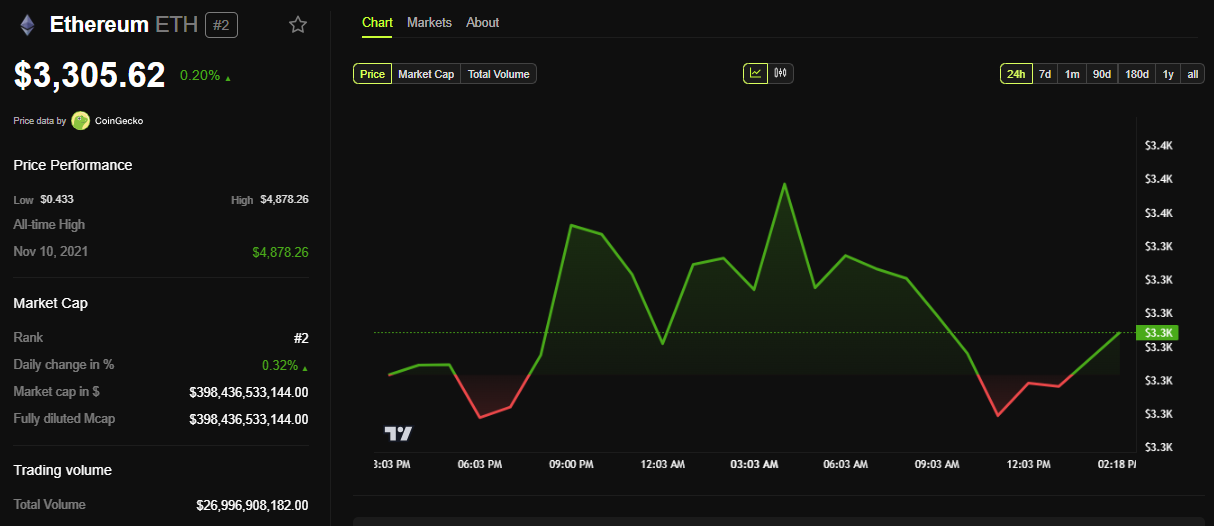
Ethereum’s ETH token was trading at $3,305 as of this writing, representing a modest 0.2% surge since Wednesday’s session opened.
Disclaimer
In adherence to the Trust Project guidelines, BeInCrypto is committed to unbiased, transparent reporting. This news article aims to provide accurate, timely information. However, readers are advised to verify facts independently and consult with a professional before making any decisions based on this content. Please note that our Terms and Conditions, Privacy Policy, and Disclaimers have been updated.
Market
Bitcoin (BTC) Whales Accumulate as Market Faces Uncertainty
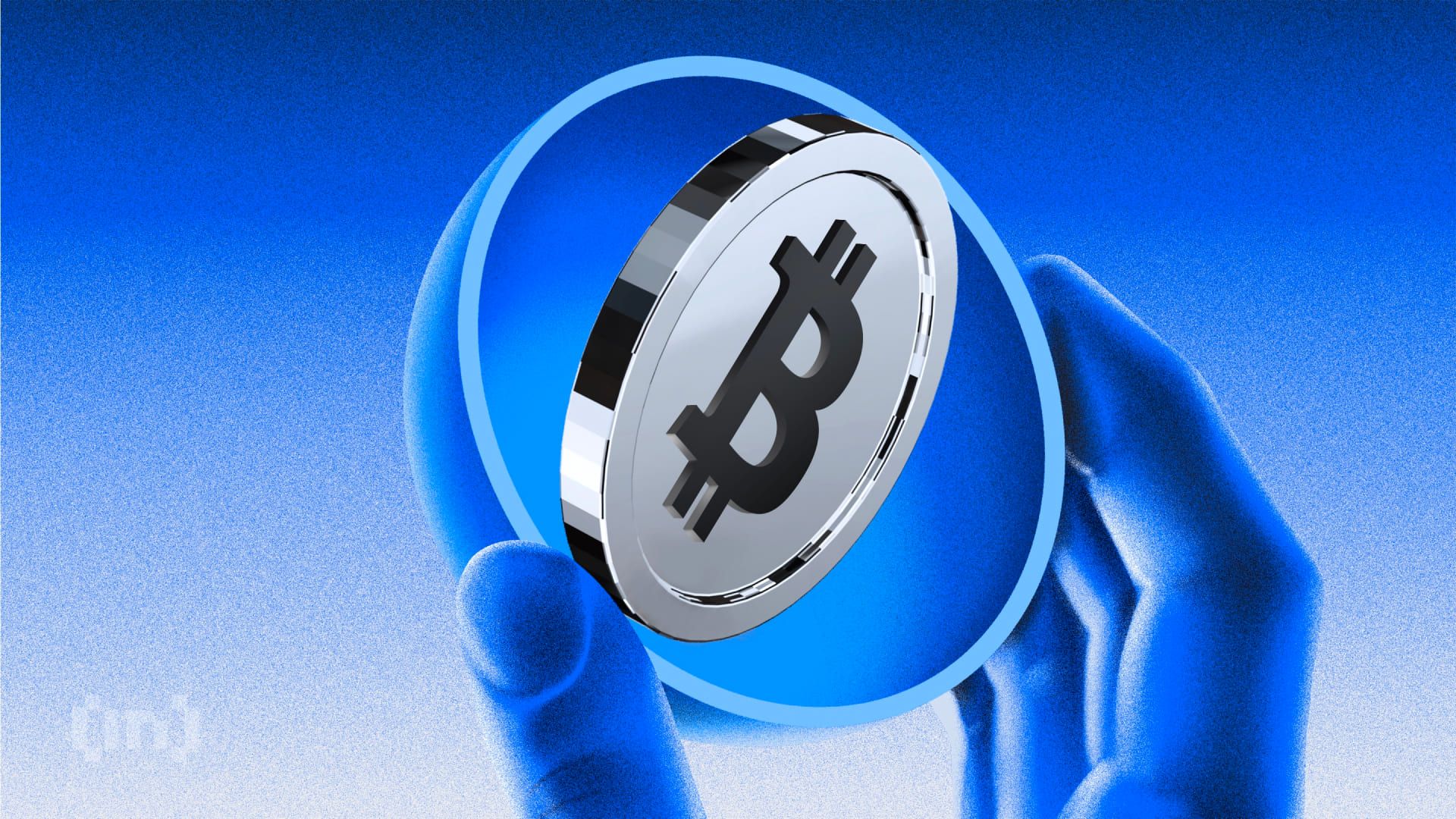
Bitcoin (BTC) has been trading below the $90,000 mark since March 7, struggling to regain upward momentum amid shifting market sentiment.
Meanwhile, technical indicators such as the Ichimoku Cloud and EMA lines suggest the trend remains bearish, though a potential reversal is not off the table.
Bitcoin Whales Just Hit Its Highest Level In More Than 3 Months
The number of Bitcoin whales—wallets holding at least 1,000 BTC—has been steadily increasing in recent weeks. On March 22, there were 1,980 such addresses, and that figure has since climbed to 1,991.
While a change of 11 might seem modest at first glance, it represents a meaningful uptick in large-scale accumulation, especially considering this is the highest number of BTC whales recorded in over three months.
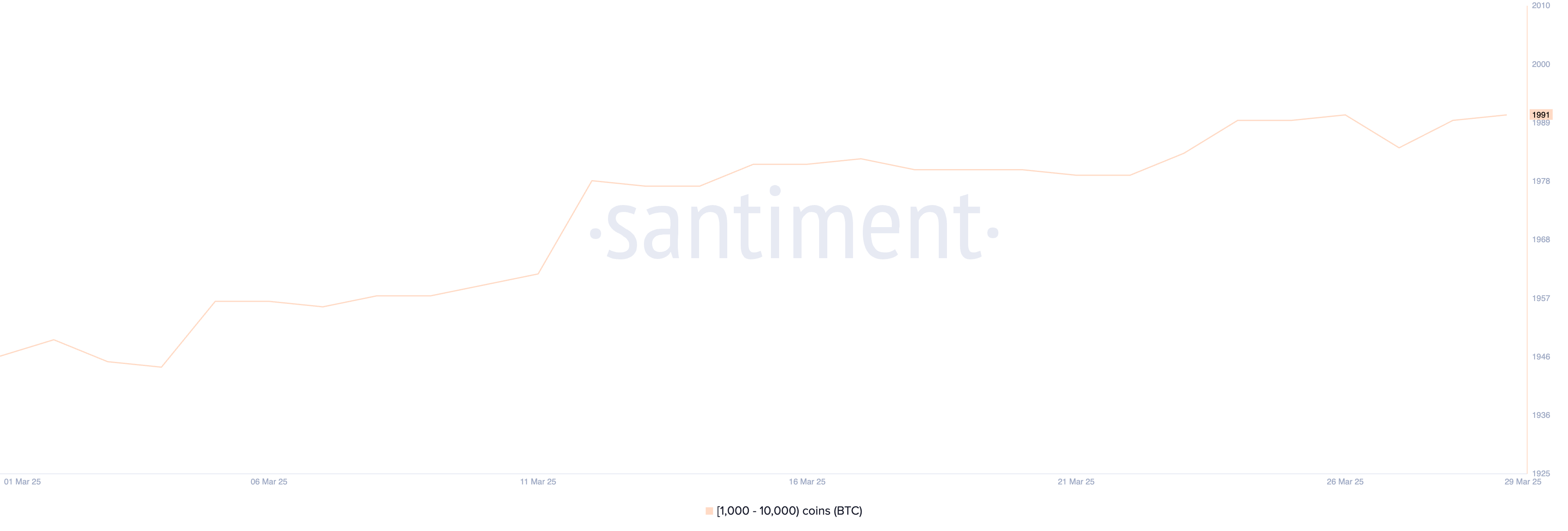
Tracking Bitcoin whales is critical because these large holders often have the power to influence price movements due to the sheer size of their positions. An increase in whale addresses can signal rising confidence among institutional investors and high-net-worth individuals.
When more whales accumulate rather than distribute, it often suggests bullish sentiment and reduced selling pressure.
With the current whale count hitting a multi-month high, it could imply that significant players are positioning ahead of a potential upward move in Bitcoin’s price.
BTC Ichimoku Cloud Shows Challenges Ahead
The Ichimoku Cloud chart for Bitcoin shows the price consolidating just below the Kijun-sen (red line) after a strong downward move.
The Tenkan-sen (blue line) remains below the Kijun-sen, indicating short-term bearish momentum. Price action is attempting to stabilize but has yet to show a decisive shift in trend.
The Lagging Span (green line) trails below both the price and the cloud, reinforcing a bearish outlook from a historical perspective.
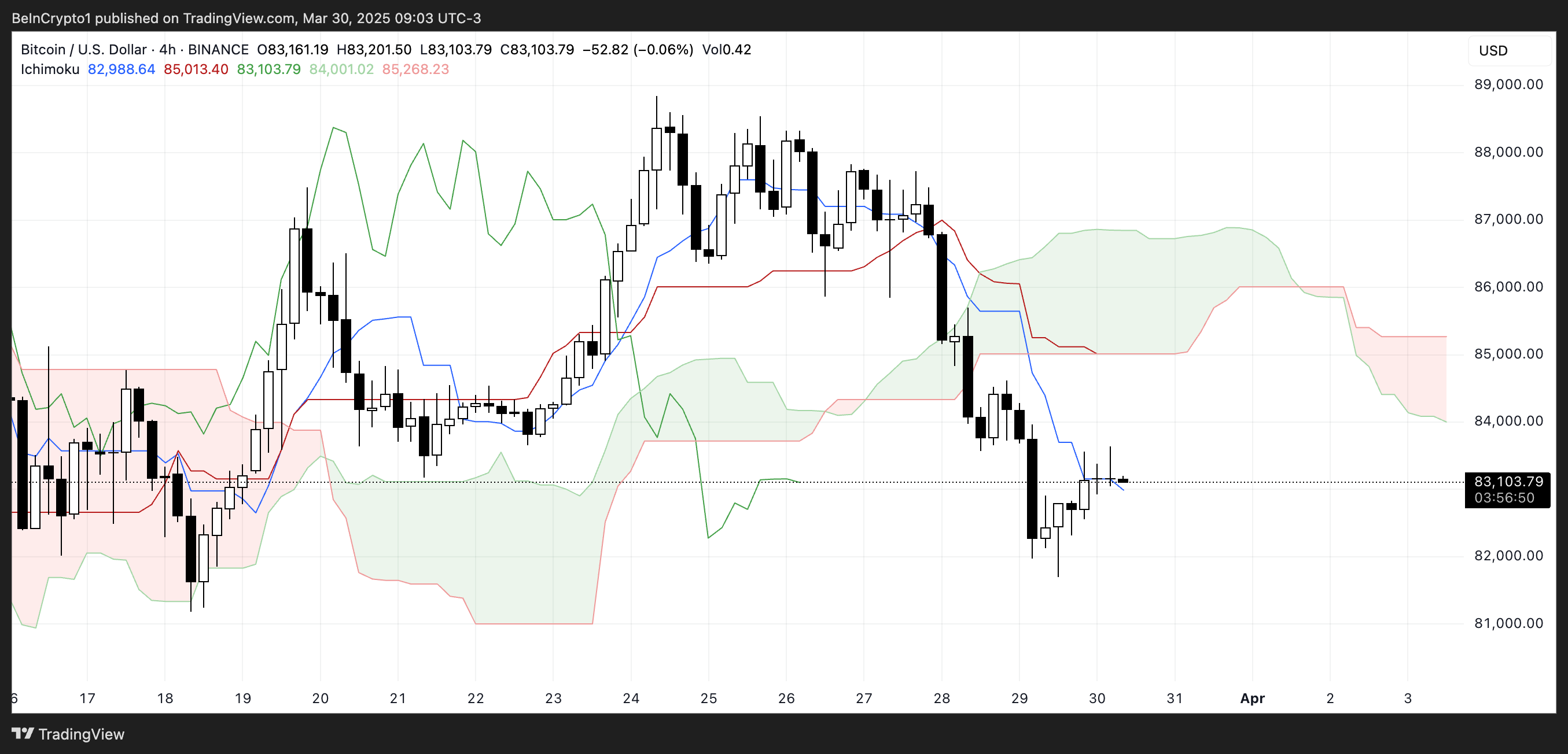
The Kumo (cloud) ahead is bearish, with the Senkou Span A (green cloud boundary) positioned below the Senkou Span B (red cloud boundary), and the cloud itself projecting downward.
This suggests resistance overhead and limited bullish momentum unless price manages to break through the cloud decisively.
The thin structure of the current cloud, however, hints at possible vulnerability—if buyers step in with strength, there could be a window for a reversal.
But for now, the overall setup favors caution, as the prevailing trend remains bearish according to Ichimoku principles.
Can Bitcoin Rise To Test $88,000 Soon?
Bitcoin’s EMA lines continue to indicate a downtrend, with short-term moving averages positioned below the longer-term ones. This alignment suggests bearish momentum remains dominant for now.
However, if buyers can regain control and establish an uptrend, Bitcoin price may climb toward the next key resistance levels.
The first challenge would be the resistance near $85,124—if broken, this could open the path to $87,482 and potentially $88,839, assuming bullish momentum strengthens and sustains.
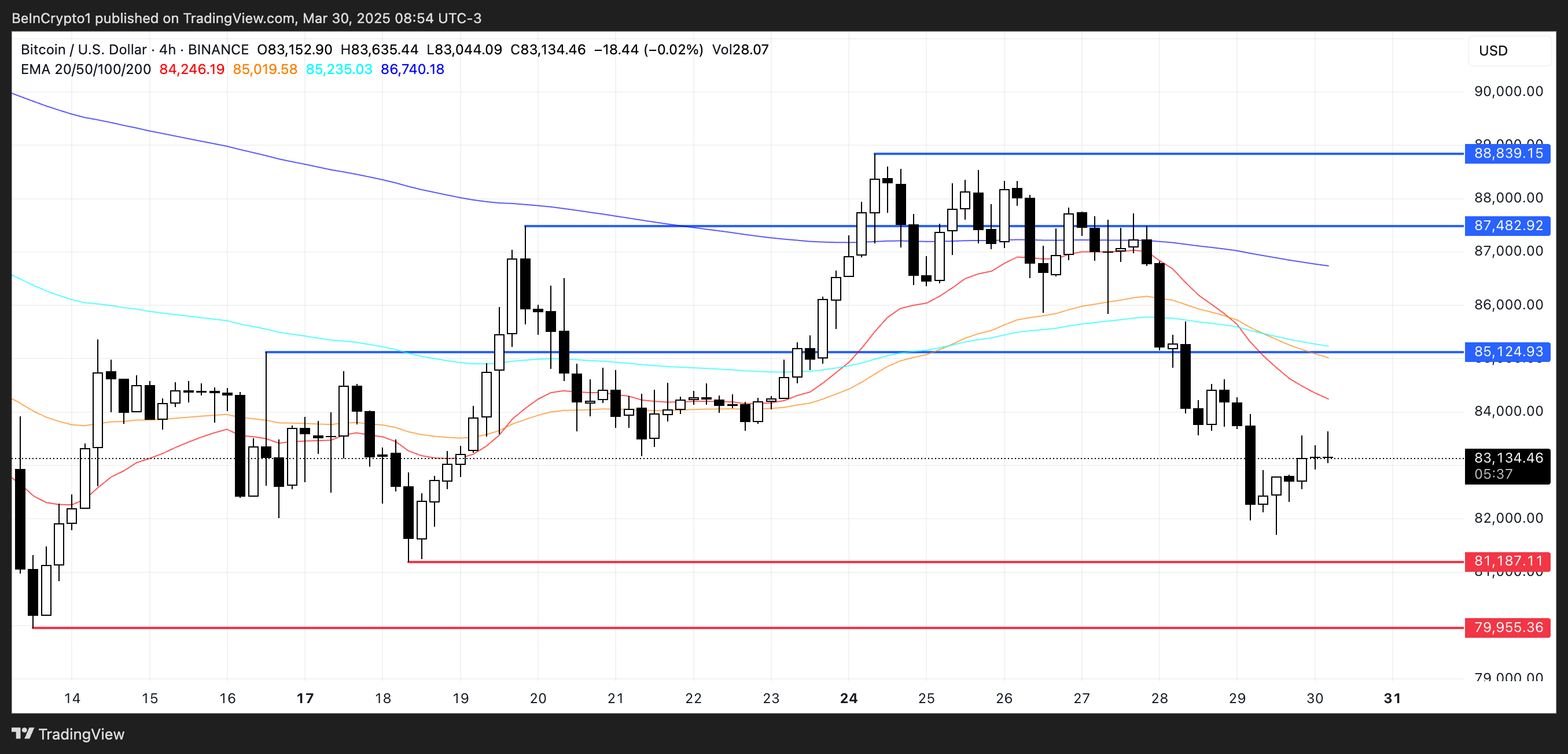
On the flip side, failure to build upward momentum would reinforce the current bearish structure.
In that case, Bitcoin could revisit the support level around $81,187.
A breakdown below this point would further validate the downtrend, potentially dragging the price down to $79,955.
Disclaimer
In line with the Trust Project guidelines, this price analysis article is for informational purposes only and should not be considered financial or investment advice. BeInCrypto is committed to accurate, unbiased reporting, but market conditions are subject to change without notice. Always conduct your own research and consult with a professional before making any financial decisions. Please note that our Terms and Conditions, Privacy Policy, and Disclaimers have been updated.
Market
Whale Leverages $27.5 Million PEPE Long on Hyperliquid

A crypto whale’s high-stakes, 10x leveraged PEPE position on Hyperliquid faces mounting risk. The whale’s leveraged PEPE bet remains precarious, risking liquidation amid market instability.
With added margin but persistent losses, any adverse price move could trigger cascading sell-offs and broader crypto turbulence.
Whale Opens 10X Leverage on PEPE
Crypto and DeFi analyst Ai revealed a notable gamble by a whale trader, placing a high-stakes bet on the PEPE meme coin. They opened a 10x leveraged long position worth $27.53 million on the Hyperliquid network.
However, the trade quickly turned against them, with unrealized losses amounting to $3.238 million.
The whale, identified by the address 0x507…BeDb6 initiated the position on March 24 at an entry price of $0.00814 per 1,000 PEPE. As it stands, they are now at risk of liquidation should the price fall to $0.005219.
To prevent forced closure, they have added 3.818 million USDC in margin (approximately $3.8 million).
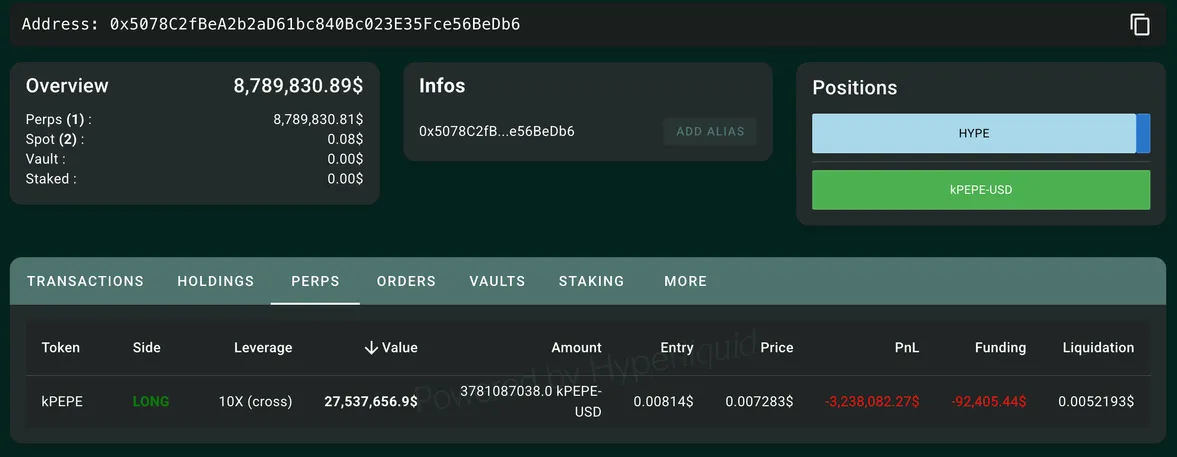
The precarious nature of the position raises concerns about the broader risks to PEPE’s market stability and the implications for leveraged trading on Hyperliquid.
Using 10X leverage dramatically amplifies potential gains and losses, making this a highly volatile bet. Even minor price fluctuations can lead to significant swings in the whale’s account balance.
If PEPE’s price continues to decline and reaches the liquidation threshold, Hyperliquid’s automated systems will forcibly close the position.
This could further drive down PEPE’s price. Such liquidations often lead to cascading sell-offs as other leveraged traders get caught in a feedback loop, exacerbating market volatility.
Meanwhile, the whale’s decision to inject more margin suggests they are committed to defending their position. However, this also signals the pressure they are under to maintain solvency.
What Are the Perceived Risks?
PEPE’s inherent volatility adds another layer of risk. As a meme coin, its price movements are often driven by social sentiment rather than fundamental value. This makes it particularly vulnerable to quick price swings, which could trouble the whale’s position.
If negative market sentiment prevails due to external factors such as regulatory news or shifting trader interest, PEPE’s price could decline further.
Given that the market has already been experiencing a downturn, the likelihood of additional price pressure remains a significant concern.
Another critical issue is the potential for whale-induced market manipulation. Large-scale traders have the power to sway market trends, either through direct trades or by influencing sentiment.
By continuously adding margin to avoid liquidation, the whale may attempt to prop up PEPE’s price and prevent a major sell-off.
However, such efforts can only go so far. If the whale ultimately exits their position, it could trigger panic among smaller traders, leading to a rapid decline in PEPE’s value.
The broader impact on retail investors closely tracking whale activity could exacerbate instability.
The risks associated with liquidation cascades also cannot be ignored. Hyperliquid’s decentralized liquidation mechanism allows efficient order processing.
However, a large liquidation can spark a chain reaction in highly leveraged markets.
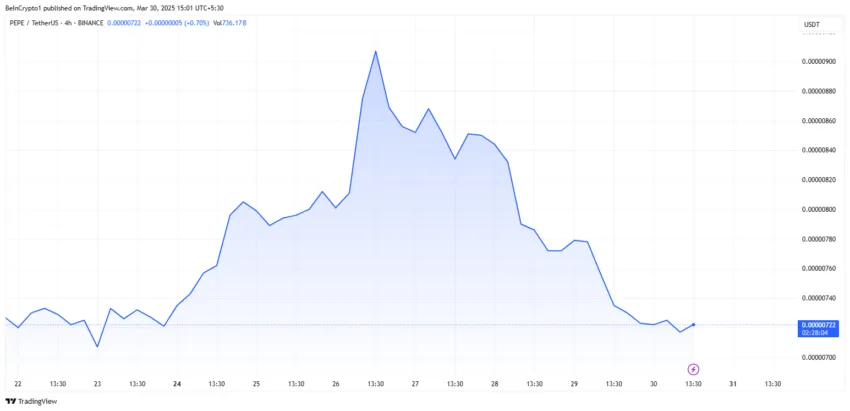
The PEPE price has fallen by over 5% in the last 24 hours and was trading for $0.00000721 as of this writing.
If PEPE’s price nears the whale’s liquidation point, other traders may begin preemptively selling to avoid losses, creating a snowball effect.
This could result in PEPE experiencing sharp price declines quickly, potentially affecting other meme coins and broader crypto markets.
KOL Opens Similar Leverage Position for Ethereum
The risks are not limited to PEPE alone. A similar situation is unfolding with another prominent trader, CBB, a Key Opinion Leader (KOL) on X. They opened a 10X leveraged long position on Ethereum (ETH) worth $2.11 million.
Currently, they are facing an unrealized loss of $1.035 million due to an entry price of $2,730. Given current market conditions, this has proven to be too high.
However, unlike the PEPE whale, this trader has a more comfortable margin buffer, with a liquidation price of $1,167.8.
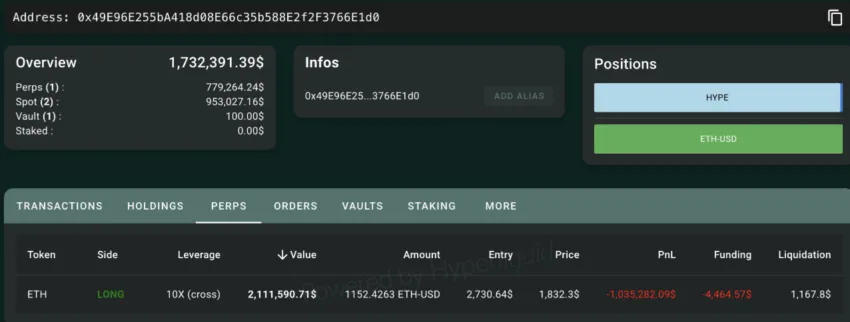
While not in immediate danger, this case further reflects the precarious nature of highly leveraged trading in volatile markets.
The unfolding drama surrounding these positions highlights the risks of excessive leverage, particularly in a declining market.
With PEPE’s whale struggling to maintain their position and Ethereum’s long traders facing mounting losses, the broader crypto market could see increased volatility in the coming days.
Disclaimer
In adherence to the Trust Project guidelines, BeInCrypto is committed to unbiased, transparent reporting. This news article aims to provide accurate, timely information. However, readers are advised to verify facts independently and consult with a professional before making any decisions based on this content. Please note that our Terms and Conditions, Privacy Policy, and Disclaimers have been updated.
Market
Can Ethereum’s Utility Make a Comeback Against Bitcoin?

Ethereum (ETH) is still a leader in decentralized finance (DeFi) and smart contract applications, but it’s at a crossroads. The community has questioned Ethereum’s relevance in the shifting crypto industry, putting the altcoin’s future under intense scrutiny.
Mainstream narratives paint a dark picture of Ethereum’s developer exodus and underperformance.
Is Ethereum Getting Left Behind?
Critics reflect how Bitcoin’s ideological and political dominance, particularly after President Donald Trump’s pro-crypto stance, overshadowed Ethereum’s early promise of a global, decentralized computer.
Ethereum’s price downturn — down 44% in 2025 — is being driven by the exodus of developers, and network activity dropping 17% last year.
In contrast, Solana has spiked with an 83% uptick in developer engagement, partly driven by its adoption of meme coins and fast transaction speeds.
Standard Chartered analysts also cut their end-of-year Ether price forecast by 60%, based on what they told clients was Ethereum’s “identity crisis” and unclear direction forward.
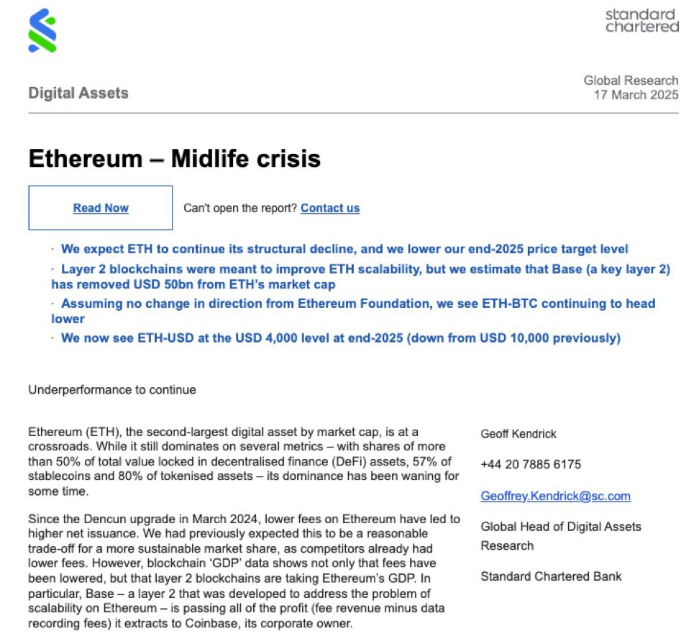
Ethereum’s co-founder, Vitalik Buterin, acknowledged the growing criticism but rejected demands for quick fixes.
He reiterated Ethereum’s trajectory hinges on “long-term value” and real-world utility, not short-term speculation or political power.
“The only thing that can move Ethereum forward at this point is things that give long term value in a way where you can clearly see that the value is coming from a thing that is actually sustainable — like actual use for people,” Bloomberg reported citing Buterin.
Grassroots Push: Ethereum’s Loyalists See Opportunity
Despite growing critics, Ethereum’s most diehard supporters remain undeterred. They view the pessimism around the largest altcoin by market cap metrics as an inflection point for a turnaround.
“This is a bottom signal. Mainstream media almost always get the timing wrong,” a user on X remarked.
Ethereum Layer-2 (L2) solutions continue to dominate chain activity, while real-world asset (RWA) growth on Ethereum looks “exponential,” the user added.
Other users also reacted to the Bloomberg article, which renewed bullishness.
“Was starting to feel bearish but this post has me all bulled up again,” one added in a post.
These responses, among others, speak to Ethereum’s strong community, which has tended to shine in the face of adversity and innovation.
There is no political spectacle for Ethereum, unlike Bitcoin, with growth hinging on scalability and real-world use.
Recently, Buterin outlined a roadmap to Ethereum’s L2 ecosystem, calling for funding of open-source development to guarantee continued progress.
His vision is already coming to fruition as projects like Celo successfully transition to Ethereum layer-2 solutions. As BeInCrypto reported, Celo completed the migration after 20 months of testing, which aimed to improve scalability and transaction efficiency.
Adoption of Ethereum’s L2 scaling solutions, such as Arbitrum, Optimism, and Polygon, has also increased.
This aligns with Buterin’s perspective that sustainable blockchain growth comes from strengthened infrastructures, not hype-driven narratives.
These moves indicate that while speculation on Ethereum may be declining, long-term technological adoption could pick up the slack.
Can the Pectra Upgrade Flip the Narrative?
Likewise, Ethereum managed to overcome challenges through significant upgrades. Against that backdrop, its soon-to-be-released Pectra Upgrade could be revolutionary.
Though delays have frustrated some in the community, the upgrade is anticipated to offer improved security, transaction efficiency, and developer-friendly tools.
Ethereum’s continued commitment to innovation and ongoing testnet trials may be the perfect catalyst for reclaiming its DeFi throne. The network’s dominance in decentralized finance (DeFi) and NFT (non-fungible tokens) ecosystems proves particularly resilient.
Indeed, meme coins and speculative trading have shifted to faster chains such as Solana.
That said, when it comes to high-value applications, Ethereum is still at the heart of it all — from decentralized exchanges (DEXs) to institutional-grade financial products.
The question now, however, is whether Ethereum’s focus on real-world adoption can preserve and outlast Bitcoin’s dominance in the halls of political and financial attention.
With the Pectra upgrade on the horizon and a community loyal to the chain’s dominance in the ecosystem, Ethereum may soon show again that its greatest strength lies not in the hype but in resilience and innovation.
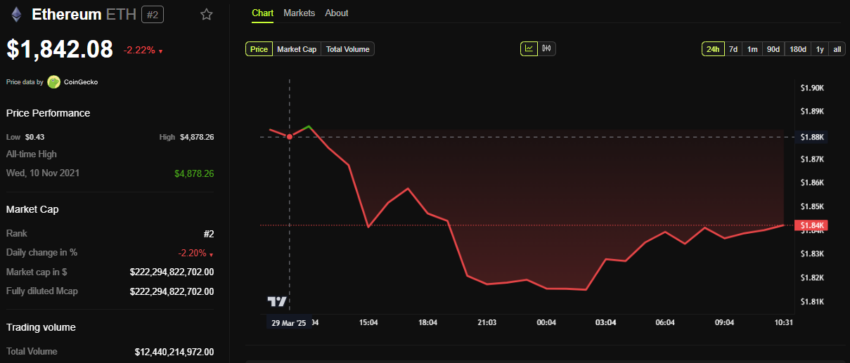
Despite community optimism, Ethereum’s price is down by 2.22% in the last 24 hours. BeInCrypto data shows ETH was trading for $1,842 as of this writing.
Disclaimer
In adherence to the Trust Project guidelines, BeInCrypto is committed to unbiased, transparent reporting. This news article aims to provide accurate, timely information. However, readers are advised to verify facts independently and consult with a professional before making any decisions based on this content. Please note that our Terms and Conditions, Privacy Policy, and Disclaimers have been updated.
-

 Altcoin20 hours ago
Altcoin20 hours agoPepe Coin Whale Sells 150 Billion Tokens, Price Fall Ahead?
-
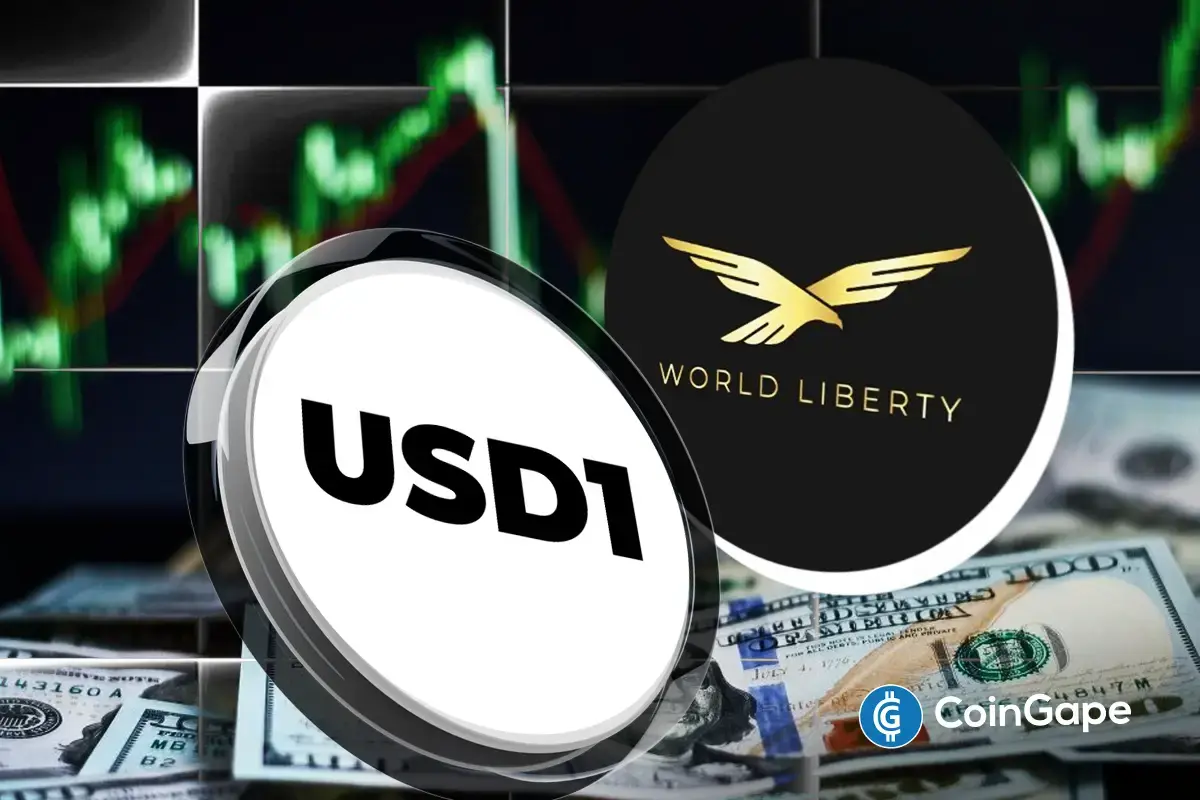
 Altcoin22 hours ago
Altcoin22 hours agoExpert Predicts Listing Date For WLFI’s USD1 Stablecoin, Here’s When
-

 Market20 hours ago
Market20 hours agoONDO Whales Retreat as Price Risks Dropping Below $0.70
-

 Market19 hours ago
Market19 hours agoXRP Falls 12% in a Week as Network Activity Declines
-

 Altcoin19 hours ago
Altcoin19 hours agoIs Burger King Teasing Crypto Launch? Decoding Their X Post
-

 Ethereum19 hours ago
Ethereum19 hours agoEthereum Bulls Disappointed As Recovery Attempt Fails At $2,160 Resistance
-

 Market22 hours ago
Market22 hours agoVitalik Buterin Promotes Ethereum Layer 2 Roadmap
-

 Market21 hours ago
Market21 hours agoGRASS Jumps 30% in a Week, More Gains Ahead?










